Migration Profiles define settings for certain groups of users. For instance, you can use filters to migrate types of documents, enable size or date restrictions and set the logging level. Refer to the Migrator for Notes Installation and Configuration guide for details. Every user must have a Migration Profile set before a migration can proceed.
To set a migration status:
Expand the Migration | 1. Set Migration Profile views, select users and click the Set Migration Profile button:
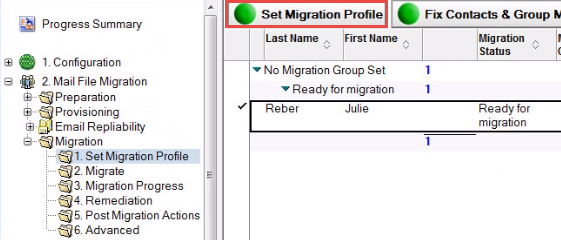
Set Migration Profile View
Select users and click the Set Migration Profile button in the Data Pane
The Select Migration Settings dialog box appears; the list consists of the migration profile(s) you have created; select a profile from the list, and then click OK
Notice that the profile has been assigned to the users; the users in the Data Pane are ready to be migrated
The Set Migration Profile view also contains options to fix Contacts, Group members, Folders, Unread items and options to maintain the transitional calendar workflow (MTCW):

|
|
The MTCW is only required if Binary Tree Integration for Notes has been deployed. This will update the repeating meeting cache for Notes Integration which is used to support meeting changes made by users between Notes (prior to migration) and Outlook (post migration). This processing does require access to all Notes mail files to collect repeating meeting information from the chair person for all relevant meetings. If this action is not completed for any reason prior to migration it can be run post migration to update the repeating meeting cache. There may be some instances of repeating meeting updates between Notes and Outlook returning a NDR for the migrated users before the cache is updated. This uses the ApptUNID unique identifier for meetings and will not create duplicates in the cache. |
|
|
Fix Chat will only appear if the Settings | Other Settings | Process Sametime History is set to MIME and does not need to be run if the user does not save Sametime Chat transcripts or if the chat documents are migrating with correct HTML formatting. |
|
|
Fix Unread will only appear if Staging Replicas are enabled. |
After you have resolved users and assigned a migration profile to them, they are ready to be migrated.
|
|
Make sure that user mailboxes have been created in Microsoft Exchange prior to migration and your Outlook Migration account or group has Full Access to the mailboxes. If you are using AWD, be sure to close your migration worker application on the migration control center by right-clicking the application in the system tray and selecting Exit. This will allow your migrations to submit to the migration workstation. It is recommended to use AWD with at least one migration worker as migrating on the migration control center can interrupt the use of the Migrator for Notes application for migration management. If you are migrating to a .pst file, users do not need to be matched and users’ mailboxes do not have to exist in Microsoft Exchange but an Internet Address is required on the accounts. |
To migrate users:
Expand the Migration | Migrate view in the Navigation Pane
Click the Refresh Migration Status button to show the most current and accurate migration status
Select user(s) that are ready for migration, and then click Migrate Users in the Data Pane:
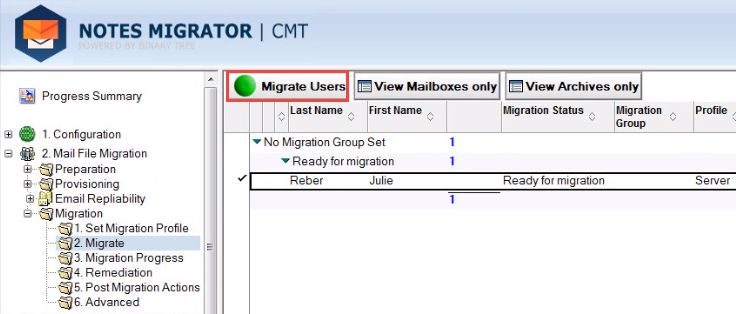
Migrate View
The Select migration priority dialog box appears:

The following table describes each option:
|
Option |
Description |
|
Add to migration queue (normal priority) |
Selected users are added to the bottom of the migration queue and will be migrated as soon as a migration workstation becomes available. |
|
Schedule migration on or after |
Selected users will be migrated on the specified date or time or later if there is heavy traffic. You can specify the exact time when you want the user mail migration to start. |
If prompted for a Notes password, specify the password to the Notes login ID you are currently using. If you accidentally specify the wrong password, delete the password.txt file from C:\Program Files\Binary tree\CMT Exchange and then try again:
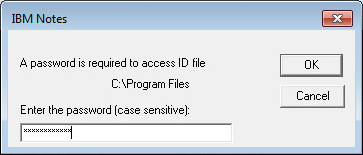
|
|
The CMT progress box displays the files being migrated on the workstation that the migration job was assigned to. This can be checked in the CMTMonitor web browser page on the migration control center. You can pause or cancel the migration by clicking the Pause and Cancel button, respectively. Depending on the amount of data for the user that is being migrated, the processing may take some time:

|
|
On migration workers the Connectivity Tester can be used to verify the Migration Outlook account and allows for changing the account and password that is stored on the worker. |
As migrations are submitted from the Migrate view, they will then be moved to the Migration Progress view and show as Pending. You can check the status on the Migration Progress view. The status of the accounts in the view can be updated by clicking the Refresh Migration Status button. When a migration workstation selects a user from a queue, the migration status changes to In Progress in the Data Pane.
Once the migration process is complete, the migration status of all users will be updated. For users that are migrated successfully these will be displayed on the Post Migrations Actions view.
For users who have not completed successfully, these will be displayed on the Remediation view.
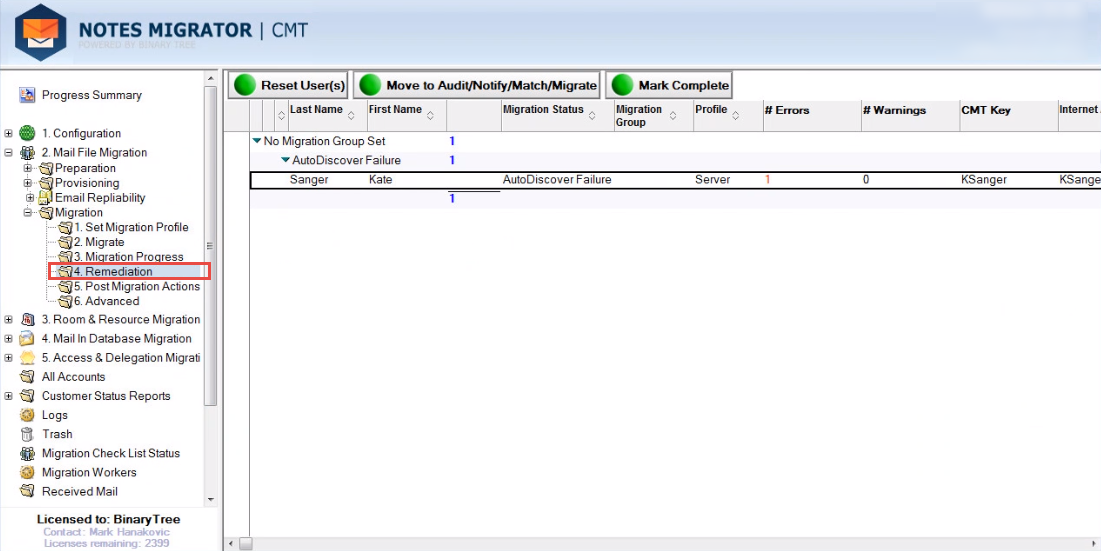
After you send the Archive Processing (Archive Migrator for Notes must be installed and configured for local archive replication and processing) message template to users, the end user clicks on the button to copy/replicate their local archives to the Domino server. Once completed, a new archive Person document will be created for each archive database copied to the server and located in the Set Migration Profile view.
To view which archive database will be migrated, double-click and open the username archive Person document
Assign a migration profile and the user will be promoted to the Migrate view to perform the migration
Once users’ archive databases have been physically resolved and audited, they are migrated the same way as users’ mail files; they can be migrated to the Exchange mailbox, the Exchange archive mailbox, or to a PST file
|
|
|
|
|
|
Direct migrations of data from Domino production mail files (not source archives) to the Exchange Archive Mailboxes are supported for both on-premise and Office 365 versions of Exchange. If enabled, Exchange archive documents are created during the matching phase if an archive exists for the user in Exchange. Like other migrations, Exchange Archive migrations are managed by Migration Profiles.
Expand the Settings view and then click the Mail File Processing tab; in the Create Exchange Archive Documents field, select Yes. Then click Save & Close:


During Match Usernames step, select users and select the Match Selected users using PowerShell or Match all users using PowerShell option; the PowerShell matching method is required to generate the Exchange Archive documents:

During the matching process, an Exchange Archive document for each user is created in addition to the Exchange Mailbox document if an Exchange archive exists for the user. The Exchange Archive document can be identified by the appended “-EXArchive”.
|
|
|
The Exchange Mailbox document and Exchange Archive document are linked in the Notes Migrator.nsf (EMM) database but are migrated as distinct documents as they do not share migration histories. The link between the two documents can be further seen when opened. The Exchange Mailbox document displays the status of Exchange Archive document and a button to open the Exchange Archive document. Likewise, the Exchange Archive document displays the status of the Exchange Mailbox document and a button to open it.
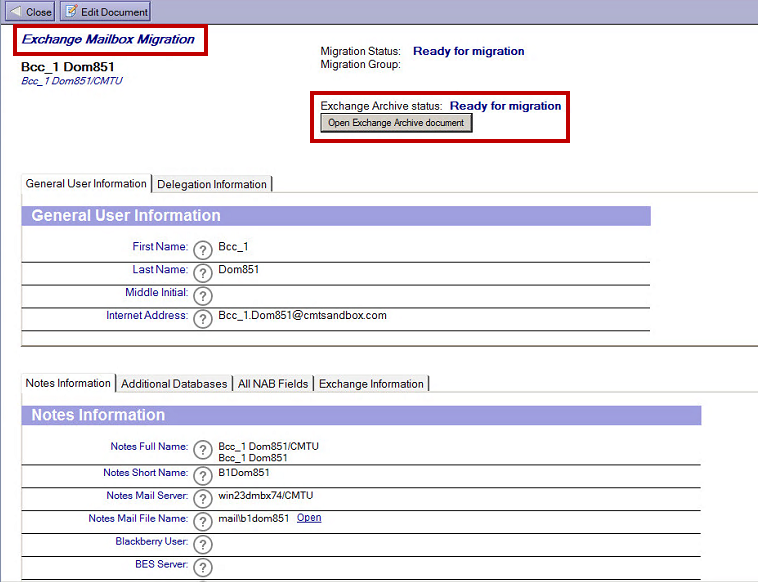

During the Set Migration Profile step, select one or more Exchange Archive document(s) and set a Migration Profile; Migration Profiles are created in the Configuration view
During the Migrate step, select one or more Exchange Archive document(s) and click Migrate Users; the Exchange Archive documents are migrated to the Exchange archive; the View Mailboxes only and View Archives only buttons allow you to filter the displayed list
The option to create Exchange archive documents is necessary for the local archives (above) to be migrated to online Exchange archives; this requires PowerShell matching:

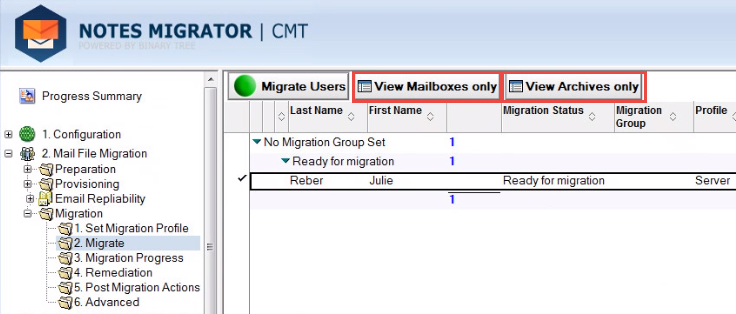
View Mailboxes only and View Archives only buttons